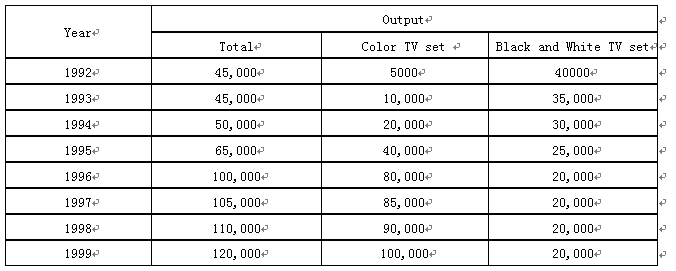6.
-
Part B
52. Directions:
Write an essay based on the following table on the production of TV sets in a factory.

You should write about 160 -200 words neatly on ANSWER SHEET II. (20 points)
-
Part A
51. Directions:
Your are asked to write a recommendation for a student. Please give your suggestions and express your opinions clearly a bout 100 words on ANSWER SHEET II. Do not sign your own name at the end of the letter. (10 points)
-
49.____________________
-
50.____________________
-
Part C
Directions: Read the following text carefully and then translate the underlined segments into Chinese. Your translation should be written clearly on ANSWER SHEET II. ( 10 points)
Do animals have rights.'? This is how the question is usually put. It sounds like a useful, ground clearing way to start. 46)Actually, it isn't, because it assumes that there is an agreed account of human rights, which is something the world does not have.
On one view of rights, to be sure, it necessarily follows that animals have none. 47)Some philosophers argue that rights exist only within a social contract, as part of an exchange of duties and entitlements. Therefore, animals cannot have rights. The idea of punishing a tiger that kills somebody is absurd, for exactly the same reason, so is the idea that tigers have rights. However, this is only one account, and by no means an uncontested one. It denies rights not only to animals but also to some people—4or instance to infants, the mentally incapable and future generations.
In addition, it is unclear what force a contract can have for people who never consented to it, how do you reply to somebody who says "I don' t like this contract" ?
The point is this: without agreement on the rights of people, arguing about the rights of animals is fruitless. 48 )It leads the discussion to extremes at the outset: it invites you to think that animals should be treated either with the consider- ation humans extend to other humans, or with no consideration at all. This is a false choice. Better to start with another, more fundamental, question: is the way we treat animals a moral issue at all?
Many deny it. 49)Arguing from the view that humans are different from animals in every relevant respect, extremists of this kind think that animals lie outside the area of moral choice.
Any regard for the suffering of animals is seen as a mistake—a sentimental displacement of feeling that should properly be directed to other humans.
This view which holds that torturing a monkey is morally equivalent to chopping wood, may seem bravely "logical". In fact it is simply shallow: the confused center is right to reject it. The most elementary form. of moral reasoning—the ethical equivalent of learning to crawl—is to weigh others' interests against one's own. This in turn requires sympathy and imagination: without there is no capacity for moral thought. To see an animal in pain is enough, for most, to engage sympathy. 50)When that happens, it is not a mistake: it is mankind' s instinct for moral reasoning in action, an instinct that should be encouraged rather than laughed at.
46.____________________
-
47.____________________
-
48.____________________
-
P
- art
- B
- Dire
- ctions: In the following article, some sentences have been remove
- d. For Questions 41—45, choose the most suitable one from the list A—G to fit into each of the numbered blank. There are two extra choices, which do not fit in any of the gaps. Mark your answers on ANSWER SHEET I. ( 10 points) 41)__
- I don' t see private health care providing much of the solution to current problems. 43)____________Neither is close to being implemented, but the future could see a deliberate shift of attention to voluntary health insurance and an emphasis on social ins
-
45.____________
- 正确
- 错误
-
40. What is the tone of this passage?
- A) Practical.
- B) Humorous.
- C) Satirical.
- D) Exaggerated.
2005年初级经济师考试《旅游经济专
初级旅游经济师试题及答案一
初级旅游经济师试题及答案二
2005年初级经济师考试《邮电经济专
初级经济师试题及答案1(邮电经济)
初级经济师试题及答案1(保险经济)
初级经济师试题及答案2(邮电经济)
初级经济师试题及答案2(保险经济)
初级经济师试题及答案3(保险经济)
2014年经济师初级考试真题《建筑经
